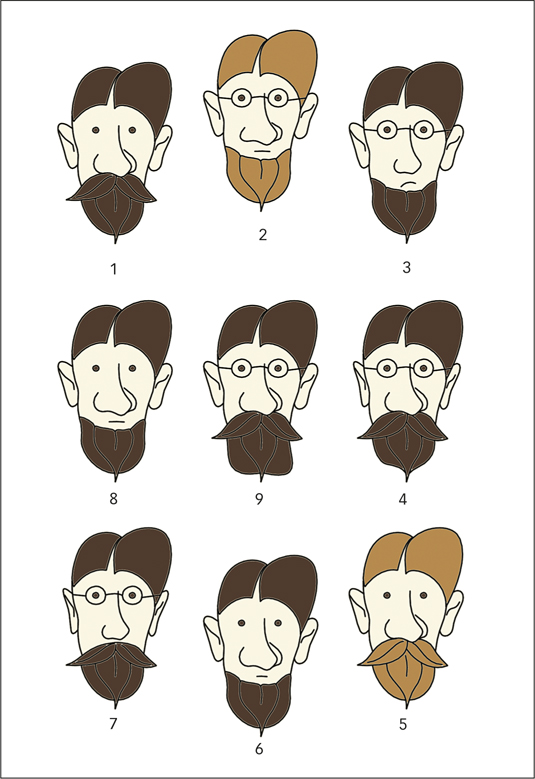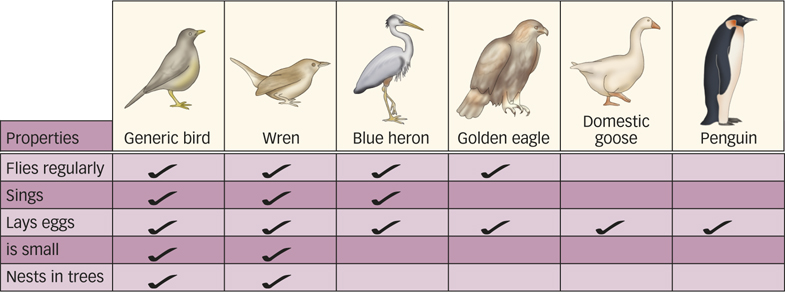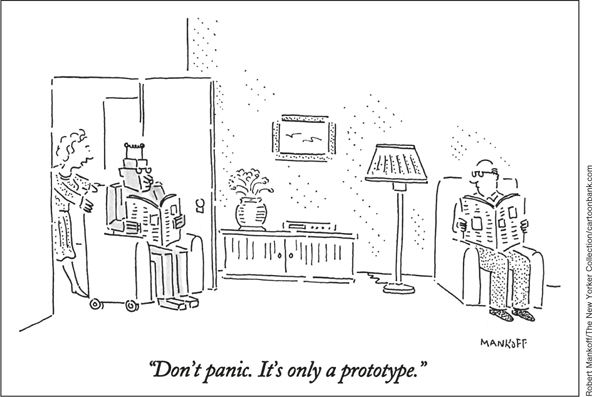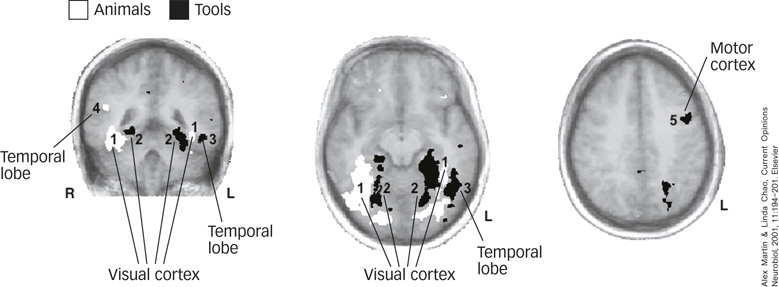9.2 Concepts and Categories: How We Think
In October 2000, a man known by the initials JB went for a neurological assessment because he was having difficulty understanding the meaning of words, even though he still performed well on many other perceptual and cognitive tasks. Over the next few years, his color language deteriorated dramatically; he had great difficulty naming colors and could not even match objects with their typical colors (e.g., strawberry and red, banana and yellow). Yet he could still classify colors normally, sorting color patches into groups of green, yellow, red, and blue. JB retained an intact concept of colors despite the decline of his language ability—
Why are concepts useful to us?
Concept refers to a mental representation that groups or categorizes shared features of related objects, events, or other stimuli. The brain organizes our concepts about the world, classifying them into categories based on shared similarities. Our category for dog may be something like “small, four-
concept
A mental representation that groups or categorizes shared features of related objects, events, or other stimuli.
Psychological Theories of Concepts and Categories
What is your definition of dog? Can you come up with a rule of “dogship” that includes all dogs and excludes all nondogs? Most people can’t, but they still use the term dog intelligently, easily classifying objects as dogs or non-
Family Resemblance Theory

Eleanor Rosch developed a theory of concepts based on family resemblance, that is, features that appear to be characteristic of category members but may not be possessed by every member (Rosch, 1973, 1975; Rosch & Mervis, 1975; Wittgenstein, 1953/1999). For example, you and your brother may have your mother’s eyes, although you and your sister may have your father’s high cheekbones. There is a strong family resemblance between you, your parents, and your siblings despite the fact that there is no single defining feature that you all have in common. Similarly, many members of the bird category have feathers and wings, so these are the characteristic features. Anything that has these features is likely to be classified as a bird because of this “family resemblance” to other members of the bird category (see FIGURE 9.4).

family resemblance theory
Members of a category have features that appear to be characteristic of category members but may not be possessed by every member.
285
Prototype Theory
Building on the idea of family resemblance, Rosch also proposed that categories are organized around a prototype, the “best” or “most typical” member of a category. A prototype possesses most (or all) of the most characteristic features of the category. For North Americans, the prototype of the bird category would be something like a wren: a small animal with feathers and wings that flies through the air, lays eggs, and migrates (see FIGURE 9.5). People make category judgments by comparing new instances to the category’s prototype. According to prototype theory, if your prototypical bird is a robin, then a canary would be considered a better example of a bird than would an ostrich because a canary has more features in common with a robin than an ostrich does.

prototype
The “best” or “most typical member” of a category.
Exemplar Theory
In contrast to prototype theory, exemplar theory holds that we make category judgments by comparing a new instance with stored memories for other instances of the category (Medin & Schaffer, 1978). Imagine that you’re out walking in the woods, and from the corner of your eye, you spot a four-

Age Fotostock/Superstock
Juniors Bildarchivi/Alamy
Pixtal/Superstock
©Imagebroker/Alamy Images
©OTS-
exemplar theory
A theory of categorization that argues that we make category judgments by comparing a new instance with stored memories for other instances of the category.
286
Concepts, Categories, and the Brain
Researchers using neuroimaging techniques have concluded that we use both prototypes and exemplars when forming concepts and categories. The visual cortex is involved in forming prototypes, whereas the prefrontal cortex and basal ganglia are involved in learning exemplars (Ashby & Ell, 2001; Ashby & O’Brien, 2005). This evidence suggests that exemplar-
How do prototypes and exemplars relate to each other?
Some of the most striking evidence linking concepts with the brain comes from patients with brain damage. One such patient could not recognize a variety of human-
category-specific deficit
A neurological syndrome that is characterized by an inability to recognize objects that belong to a particular category, although the ability to recognize objects outside the category is undisturbed.
287

The type of category-

What is the role of vision in category-
How do particular brain regions develop category preferences for objects such as tools or animals? In one fMRI study, blind and sighted individuals each heard a series of words, including some words that referred to animals and others that referred to tools. Category-
SUMMARY QUIZ [9.2]
Question 9.5
| 1. | The “most typical” member of a category is a(n) |
- prototype.
- exemplar.
- concept.
- definition.
a.
288
Question 9.6
| 2. | Which theory of how we form concepts is based on our judgment of features that appear to be characteristic of category members but may not be possessed by every member? |
- prototype theory
- family resemblance theory
- exemplar theory
- heuristic theory
b.
Question 9.7
| 3. | The inability to recognize objects that belong to a particular category, although the ability to recognize objects outside the category is undisturbed, is called |
- category-
preferential organization. - cognitive-
visual deficit. - a category-
specific deficit. - aphasia.
c.